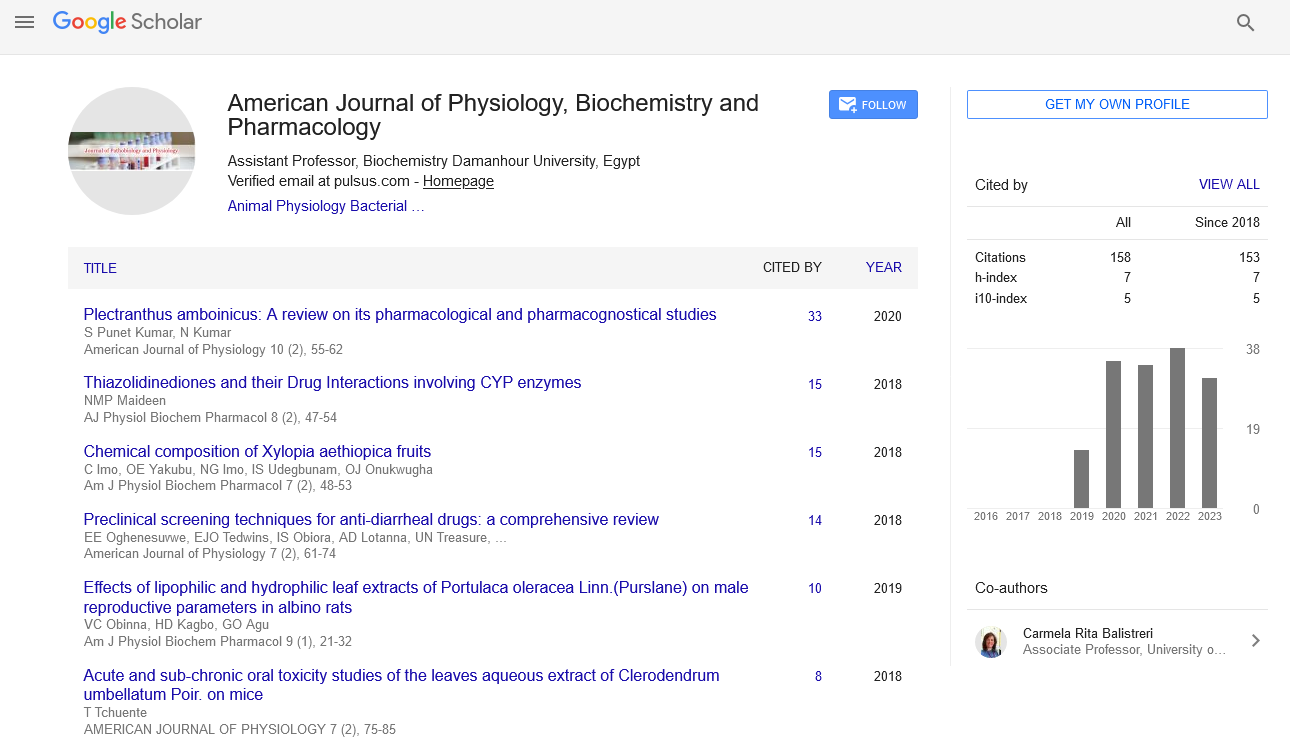Commentary - American Journal of Physiology, Biochemistry and Pharmacology (2022)
Factors on Drug Metabolism
Hasan Gill*Hasan Gill, Department of Botany, University of Benin, Benin City, Nigeria, Email: gill.hasan@mail.ub.edu.ng
Received: 01-Feb-2022, Manuscript No. AJPBP-22-53761; Editor assigned: 03-Feb-2022, Pre QC No. AJPBP-22-53761 (PQ); Reviewed: 17-Feb-2022, QC No. AJPBP-22-53761; Revised: 22-Feb-2022, Manuscript No. AJPBP-22-53761 (R); Published: 01-Mar-2022
Introduction
Drug metabolism is the biotransformation of pharmaceutical medications in the body so that they can be eliminated more rapidly. Because the enzymes that assist the reactions are concentrated in the liver, the majority of drug-related metabolic activities take place there.
The goal of metabolism in the body is to modify the chemical structure of a material in order to make it easier to eliminate it from the body.
Oxidation
The terms oxidation and reduction refer to the addition or removal of oxygen from a chemical. While this is not the most comprehensive definition, it is the easiest to remember, as detailed below. Oxidation is the loss of electrons by a molecule, atom, or ion during a process. Oxidation is the process of increasing a molecules, atoms, or ions oxidation state. When an atom, molecule, or ion obtains electrons, or when an atom, molecule, or ion’s oxidation state changes, or ion drops, the process is termed reduction. On the other hand, oxidation is to blame if you’ve ever had to cope with a rusted car or throw out browned fruit. Oxidation can be a natural process or one that is induced artificially. It can be beneficial at times, but it can also be extremely harmful.
Reduction
Reduction is a chemical reaction in which the number of electrons attached to an atom or a group of atoms is raised. The electrons taken up by the reduced molecule are provided by another substance, which is oxidised as a result. See the oxidation-reduction reaction for further information.
Hydrolysis
Hydrolysis is a chemical reaction that occurs when chemicals contact with water, causing both the material and the water to decompose. Salts, carbohydrates, proteins, lipids, and other substances can undergo hydrolysis reactions. In catabolism reactions, enzymes are usually involved in the hydrolysis of organic molecules.
Hydration
The absence of enough water in your body is known as dehydration. The best way to avoid dehydration is to drink before you get thirsty. You’re already mildly dehydrated if you’re thirsty, which can bring symptoms including headaches, lethargy, dizziness, and more. Heatstroke and other life-threatening conditions can be exacerbated by dehydration.
Conjugation
In chemistry, a conjugated system is a molecule’s system of connected p orbitals with delocalized electrons, which decreases the molecule’s overall energy and promotes stability. It is typically represented as having alternating single and multiple bonds. In a covalent chemical complex, a conjugated system is a group or chain of atoms with valence electrons that are not engaged in single-bond formation and alter each other’s behaviour.
Condensation
The transition of water vapour into liquid is known as condensation. It’s the polar opposite of evaporation, which occurs when liquid water becomes a vapour. When the air is either chilled to the dew point or saturated with water vapour to the point where it can no longer hold any more water, condensation occurs. Condensation is the deposit of a liquid or a solid from its vapour on a surface that is cooler than the surrounding gas.
Isomerization
Due to the increased need for high octane gasoline blending components and petrochemicals, the isomerization process is critical in refining, petrochemical, and gas facilities. Light naphtha isomerization is a cost-effective process in which light naphtha paraffin’s are rearranged into more highly branched paraffin’s with a higher octane number, usually in the range of 78-85, depending on feedstock qualities, working conditions, and catalyst. Butane isomerization turns low 93 RON octanes, straight chain n-butane into high 102 RON octane, branched isobutene, which is used to boost the octane number of gasoline. When a medicine is digested, it usually becomes inactive. Some medications’ metabolites, on the other hand, are pharmacologically active and have an impact on the body. In fact, the active metabolite of several drugs is what causes the drug’s main effect. The drug formulation is referred to as a prodrug in this scenario.
Copyright: © 2022 The Authors. This is an open access article under the terms of the Creative Commons Attribution NonCommercial ShareAlike 4.0 (https://creativecommons.org/licenses/by-nc-sa/4.0/). This is an open access article distributed under the terms of the Creative Commons Attribution License, which permits unrestricted use, distribution, and reproduction in any medium, provided the original work is properly cited.






